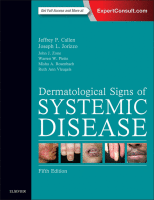Physical Address
304 North Cardinal St.
Dorchester Center, MA 02124

Key Points Systemic medications used for dermatologic conditions are associated with risks. The choice of systemic medication requires assessment of the disease severity and the performance of a risk–risk analysis balancing the risk of the disease with the risks of…

Key Points Prevent harm: Be aware of high-risk drugs and always consider a drug reaction as part of a differential diagnosis. Monitoring: Monitor for systemic involvement. Diagnosis: Determine the morphology of the eruption and decide if it is simple or…

Key Points Venous leg ulcerations are the most common cause of leg ulcers, followed by mixed venous/arterial disease and arterial insufficiency. However, up to 10% of leg ulcers are due to atypical etiologies, infections, metabolic disorders, neoplasms, and inflammatory processes.…

Key Points A thorough examination of the intraoral soft tissues, including palpation, is necessary to detect the subtle signs of systemic disease as well as localized problems such as leukoplakia. Autosomal dominant cancer syndromes may present with diverse mucous membrane…

Key Points A complete and detailed history and physical examination of all 20 nails is essential in evaluating patients with suspected manifestations of systemic disease. Subacute bacterial endocarditis is the most common systemic cause of splinter hemorrhages, which occur proximally…

Key Points Hair loss in the setting of systemic disease may occur through one of five mechanisms: telogen effluvium, anagen arrest, hair miniaturization, scarring alopecia, and hair shaft disorders. The most common cause of hair loss is telogen effluvium, which…

Key Points Mastocytosis is a disease of both children and adults. Most children have skin-limited disease and an excellent prognosis. Many adults have either cutaneous only or indolent systemic mastocytosis, and a very good prognosis. Patients with more advanced disease…

Key Points Physiologic changes associated with pregnancy have effects on the skin including pigmentary changes such as linea nigra and melasma; vascular changes such as telangiectasia, varicosities, and spider angiomata; connective tissue changes such as striae distensae; and changes on…

Key Points Neurofibromatosis is an autosomal dominant disorder characterized by cutaneous neurofibromas, café-au-lait macules, and myriad systemic features with marked variability of expression. Patients with neurofibromatosis are at risk for the development of a malignant peripheral nerve sheath tumor. Increasing…

Key Points Skin infections occur at a great frequency in solid organ and bone marrow transplant recipients largely as a consequence of immunosuppression. Neoplasms, particularly squamous cell carcinomas, occur at greater frequency, are more difficult to manage, and are more…